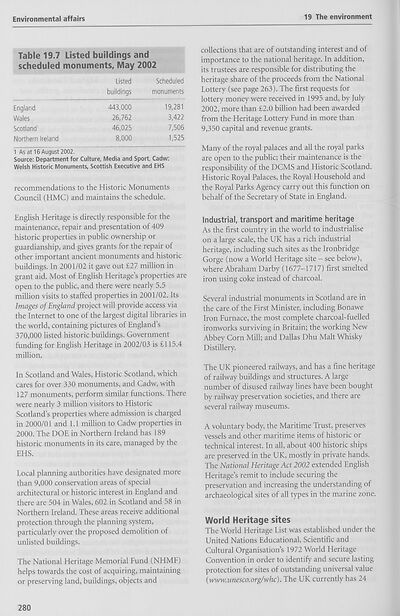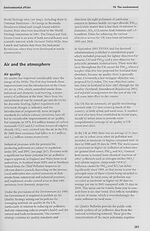Download files
Complete book:
Individual page:
Thumbnail gallery: Grid view | List view

Environmental affairs
19 The environment
Table 19.7 Listed buildings and
scheduled monuments. May 2002
Listed Scheduled
buildings monuments
England 443,000 19,281
Wales 26,762 3,422
Scotland1 46,025 7,506
Northern Ireland 8,000 1,525
1 As at 16 August 2002.
Source: Department for Culture, Media and Sport, Cadw:
Welsh Historic Monuments, Scottish Executive and EHS
recommendations to the Historic Monuments
Council (HMC) and maintains the schedule.
English Heritage is directly responsible for the
maintenance, repair and presentation of 409
historic properties in public ownership or
guardianship, and gives grants for the repair of
other important ancient monuments and historic
buildings. In 2001/02 it gave out £27 million in
grant aid. Most of English Heritage’s properties are
open to the public, and there were nearly 5.5
million visits to staffed properties in 2001/02. Its
Images of England project will provide access via
the Internet to one of the largest digital libraries in
the world, containing pictures of England’s
370,000 listed historic buildings. Government
funding for English Heritage in 2002/03 is £115.4
million.
In Scotland and Wales, Historic Scotland, which
cares for over 330 monuments, and Cadw, with
127 monuments, perform similar functions. There
were nearly 3 million visitors to Historic
Scotland’s properties where admission is charged
in 2000/01 and 1.1 million to Cadw properties in
2000. The DOE in Northern Ireland has 189
historic monuments in its care, managed by the
EHS.
Local planning authorities have designated more
than 9,000 conservation areas of special
architectural or historic interest in England and
there are 504 in Wales, 602 in Scotland and 58 in
Northern Ireland. These areas receive additional
protection through the planning system,
particularly over the proposed demolition of
unlisted buildings.
The National Heritage Memorial Fund (NHMF)
helps towards the cost of acquiring, maintaining
or preserving land, buildings, objects and
collections that are of outstanding interest and of
importance to the national heritage. In addition,
its trustees are responsible for distributing the
heritage share of the proceeds from the National
Lottery (see page 263). The first requests for
lottery money were received in 1995 and, by July
2002, more than £2.0 billion had been awarded
from the Heritage Lottery Fund in more than
9,350 capital and revenue grants.
Many of the royal palaces and all the royal parks
are open to the public; their maintenance is the
responsibility of the DCMS and Historic Scotland.
Historic Royal Palaces, the Royal Household and
the Royal Parks Agency carry out this function on
behalf of the Secretary of State in England.
Industrial, transport and maritime heritage
As the first country in the world to industrialise
on a large scale, the UK has a rich industrial
heritage, including such sites as the Ironbridge
Gorge (now a World Heritage site - see below),
where Abraham Darby (1677-1717) first smelted
iron using coke instead of charcoal.
Several industrial monuments in Scotland are in
the care of the First Minister, including Bonawe
Iron Furnace, the most complete charcoal-fuelled
ironworks surviving in Britain; the working New
Abbey Corn Mill; and Dallas Dhu Malt Whisky
Distillery.
The UK pioneered railways, and has a fine heritage
of railway buildings and structures. A large
number of disused railway lines have been bought
by railway preservation societies, and there are
several railway museums.
A voluntary body, the Maritime Trust, preserves
vessels and other maritime items of historic or
technical interest. In all, about 400 historic ships
are preserved in the UK, mostly in private hands.
The National Heritage Act 2002 extended English
Heritage’s remit to include securing the
preservation and increasing the understanding of
archaeological sites of all types in the marine zone.
World Heritage sites
The World Heritage List was established under the
United Nations Educational, Scientific and
Cultural Organisation’s 1972 World Heritage
Convention in order to identify and secure lasting
protection for sites of outstanding universal value
{www.unesco.org/whc). The UK currently has 24
280
19 The environment
Table 19.7 Listed buildings and
scheduled monuments. May 2002
Listed Scheduled
buildings monuments
England 443,000 19,281
Wales 26,762 3,422
Scotland1 46,025 7,506
Northern Ireland 8,000 1,525
1 As at 16 August 2002.
Source: Department for Culture, Media and Sport, Cadw:
Welsh Historic Monuments, Scottish Executive and EHS
recommendations to the Historic Monuments
Council (HMC) and maintains the schedule.
English Heritage is directly responsible for the
maintenance, repair and presentation of 409
historic properties in public ownership or
guardianship, and gives grants for the repair of
other important ancient monuments and historic
buildings. In 2001/02 it gave out £27 million in
grant aid. Most of English Heritage’s properties are
open to the public, and there were nearly 5.5
million visits to staffed properties in 2001/02. Its
Images of England project will provide access via
the Internet to one of the largest digital libraries in
the world, containing pictures of England’s
370,000 listed historic buildings. Government
funding for English Heritage in 2002/03 is £115.4
million.
In Scotland and Wales, Historic Scotland, which
cares for over 330 monuments, and Cadw, with
127 monuments, perform similar functions. There
were nearly 3 million visitors to Historic
Scotland’s properties where admission is charged
in 2000/01 and 1.1 million to Cadw properties in
2000. The DOE in Northern Ireland has 189
historic monuments in its care, managed by the
EHS.
Local planning authorities have designated more
than 9,000 conservation areas of special
architectural or historic interest in England and
there are 504 in Wales, 602 in Scotland and 58 in
Northern Ireland. These areas receive additional
protection through the planning system,
particularly over the proposed demolition of
unlisted buildings.
The National Heritage Memorial Fund (NHMF)
helps towards the cost of acquiring, maintaining
or preserving land, buildings, objects and
collections that are of outstanding interest and of
importance to the national heritage. In addition,
its trustees are responsible for distributing the
heritage share of the proceeds from the National
Lottery (see page 263). The first requests for
lottery money were received in 1995 and, by July
2002, more than £2.0 billion had been awarded
from the Heritage Lottery Fund in more than
9,350 capital and revenue grants.
Many of the royal palaces and all the royal parks
are open to the public; their maintenance is the
responsibility of the DCMS and Historic Scotland.
Historic Royal Palaces, the Royal Household and
the Royal Parks Agency carry out this function on
behalf of the Secretary of State in England.
Industrial, transport and maritime heritage
As the first country in the world to industrialise
on a large scale, the UK has a rich industrial
heritage, including such sites as the Ironbridge
Gorge (now a World Heritage site - see below),
where Abraham Darby (1677-1717) first smelted
iron using coke instead of charcoal.
Several industrial monuments in Scotland are in
the care of the First Minister, including Bonawe
Iron Furnace, the most complete charcoal-fuelled
ironworks surviving in Britain; the working New
Abbey Corn Mill; and Dallas Dhu Malt Whisky
Distillery.
The UK pioneered railways, and has a fine heritage
of railway buildings and structures. A large
number of disused railway lines have been bought
by railway preservation societies, and there are
several railway museums.
A voluntary body, the Maritime Trust, preserves
vessels and other maritime items of historic or
technical interest. In all, about 400 historic ships
are preserved in the UK, mostly in private hands.
The National Heritage Act 2002 extended English
Heritage’s remit to include securing the
preservation and increasing the understanding of
archaeological sites of all types in the marine zone.
World Heritage sites
The World Heritage List was established under the
United Nations Educational, Scientific and
Cultural Organisation’s 1972 World Heritage
Convention in order to identify and secure lasting
protection for sites of outstanding universal value
{www.unesco.org/whc). The UK currently has 24
280
Set display mode to:
![]() Universal Viewer |
Universal Viewer | ![]() Mirador |
Large image | Transcription
Mirador |
Large image | Transcription
The item on this page appears courtesy of Office for National Statistics and may be re-used under the Open Government Licence for Public Sector Information.
| Britain and UK handbooks > UK: The official yearbook of the United Kingdom of Great Britain and Northern Ireland > 2003 > (314) |
|---|
| Permanent URL | https://digital.nls.uk/204927192 |
|---|
| Attribution and copyright: |
|
|---|---|
| Description | Three volumes of 'UK: The official yearbook of the United Kingdom of Great Britain and Northern Ireland', published annually by the Office of National Statistics from 2002-2005. |
|---|---|
| Shelfmark | GII.11 SER |
| Description | Three titles produced by the British Government from 1954-2005 describing 'how Britain worked'. They are: 'Britain: An official handbook' (1954-1998), 'Britain: The official yearbook of the United Kingdom' (1999-2001), and 'UK: The official yearbook of the United Kingdom of Great Britain and Northern Ireland' (2002-2005). These 50 reports provide an overview of Britain's economic, social and cultural affairs, its environment, international relations, and the systems of government. They give an impartial summary of government policies and initiatives, and explain how public services are organised. |
|---|---|
| Additional NLS resources: |
|

